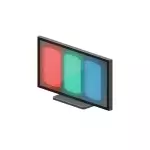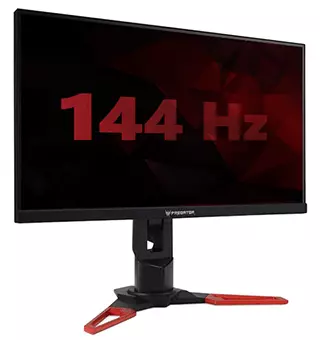
In this review - in detail about the differences between different matrices, about what is better: IPS or TN is possible - VA, as well as why the answer to this question is not always unambiguous. See also: Monitors with a USB Type-C and Thunderbolt 3, Matte or glossy screen - What is better?
IPS VS TN VS VA - Main Differences
For starters, about the main differences of different types of matrices: IPS. (In-Plane Switching) TN. (Twisted nematic) and VA. (as well as MVA and PVA - VERTICAL ALIGNMENT) used by the manufacture of monitors and laptop screens for the end user.
I note in advance that we are talking about some "averaged" matrices of each type, because if you take specific displays, then there may sometimes be more differences between two different IPS screens than between the average IPS and TN, which we will also talk about.
- TN matrices won by response time and Screen update frequency : Most screens with a response time 1 ms and a frequency of 144 Hz - it is TFT TN, and therefore they are more often buying for games, where this parameter can be important. IPS monitors are already available with the update frequency of 144 Hz, but: their price is still high compared to "ordinary IPS" and "TN 144 Hz", and the response time remains at 4 ms (but there are separate models where 1 ms ). Va-monitors with high update and low response time are also available, but at the ratio of this characteristic and the cost of TN - in the first place.

- IPS has The wider viewing angles And this is one of the main advantages of this type of panels, VA - in second place, TN is the last. This means that when looking at the "side" screen, the smallest number of color distortions and brightness will noticeably on IPS.

- On the IPS matrix, turn, exists Problem with illumination In the corners or edges on a dark background, if you look at the side or just have a large monitor, approximately as in the photo below.

- Color reproduction - Here, again, on average, wins IPS, their color coverage is on average better than that of TN and VA matrices. Almost all matrices with 10-bit color - IPS, but standard - 8 bits for IPS and VA, 6 bits for TN (but there is 8-bit TN-matrix).
- VA wins in indicators Contrast : These matrices better block the light and provide a deeper black color. With color reproduction, they also have an average better than TN.
- Price - As a rule, with someone close characteristics, the cost of the monitor or laptop with TN or VA matrix will be lower than with IPS.
There are other differences, which rarely pay attention: for example, TN consume less energy and, perhaps, this is not a very important parameter for the desktop (but can be important for a laptop).
What type of matrix is better for games, graphics and other purposes?
If it is - is not the first review that you read on different matrices, it is likely you have seen conclusions:- If you are a hardcore gamer, your choice - TN, 144 Hz, it is possible with G-Sync technology, or AMD-Freesync.
- Photographer or videographer, working with graphics or just watch movies - IPS, sometimes you can look at the VA.
And, if you take some average characteristics, the correct recommendations. However, many people forget about a number of other factors:
- There are low-quality IPS panels and excellent TN. For example, if we compare the MacBook Air with a TN-matrix and cheap laptop with IPS (it can be as low-end models Digma or Prestigio, and something HP Pavilion mean like 14), we see that strangely TN-matrix better results themselves in the sun, has the best color coating sRGB and AdobeRGB, good viewing angle. And though, at large angles cheap IPS-matrix does not invert colors, but at that angle, where they begin to invert TN-display MacBook Air, on a matrix of IPS there is little that can be seen (out in black). You can also, if available, to compare two of the same iPhone - with the original screen and replaced by Chinese analogue: Both IPS, but the difference is easily noticeable.
- Not all consumer properties notebook screens and computer monitors are directly dependent on the technology used in the manufacture of LCD matrix itself. For example, some people forget about such parameters as brightness: easily acquire affordable monitor 144 Hz with a claimed brightness of 250 cd / m2 (in reality, it is if achieved, it is only centered on the screen), and begin to live squinted at right angles to the monitor - ideally in a dark room. Although perhaps it would be wiser to save up a little money, or stay at 75 Hz, but a brighter screen.
As a result: you can not always give a clear answer, but what is better, focusing only on the type of matrix and possible applications. Plays an important role the budget, other display characteristics (brightness, resolution, etc.), and even the lighting in the room where it will be used. Try as carefully approach the selection before you buy and study the reviews, not relying solely on the reviews in the spirit of "the IPS TN at a price" or "It's the cheapest 144 Hz."
Other types of matrices and designations
When selecting a monitor or laptop, in addition to the common signs such as arrays, you can also meet, for which less information. First of all: All of the above types of screens may be in the designation of TFT and LCD, as they all use a liquid crystal and active matrix.
Next, about other options for the designations that you can meet:
- PLS, AHVA, AH-IPS, UWVA, S-IPS And others - various modifications of IPS technology, generally similar. Some of them are essentially, branded IPS designations of some manufacturers (PLS - from Samsung, UWVA - HP).
- SVA, S-PVA, MVA - Modifications of VA-panels.
- Igzo. - On sale you can meet monitors, as well as laptops with a matrix, which is indicated as IGZO (Indium Gallium Zinc Oxide). Abbreviation says not exactly about the type of matrix (in fact, today it is an IPS panels, but the technology is planned to be used for OLED), but about the type and material of the used transistors: if there are ASI-TFT in conventional screens, then it is igzo-TFT. Advantages: Such transistors are transparent and have smaller dimensions, as a result: a brighter and economical matrix (ASI transistors overlap part of the world).
- Oled. - While such monitors are not many: Dell UP3017Q and ASUS Proart PQ22UC (none of them was sold in the Russian Federation). The main advantage is really black (the diodes are completely turned off, there is no background backlight), hence the very high contrast, can be more compact than the analogues. Disadvantages: price, can fade over time while the young technology of manufacturing monitors is because unexpected problems are possible.
I hope I could answer some of the questions about IPS, TN matrices and others, pay attention to additional questions and help more carefully approach the selection.
